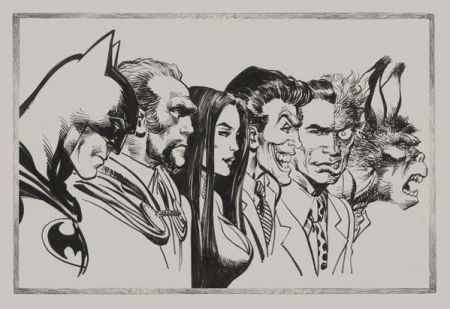A collection of obituaries and appreciations of Neal Adams.
The Guardian published their obituary of Neal Adams today.
Adams was central to the rethinking of characters including Marvel’s X-Men and, for their rival DC Comics, the Spectre, Deadman and, most crucially, the Batman.
He also brought about changes to business practices, most notably winning artists the right to their original artwork, and getting long-delayed credit and compensation in the 1980s for the Superman creators Jerry Siegel and Joe Shuster.
“He reinvented the look of comic pages and characters,” said the writer Neil Gaiman.
The New York Times obituary appeared a couple days ago:
Characters drawn by Mr. Adams were more grounded in reality than his predecessors’. The anguish of Deadman, the ghost of a trapeze artist trying to solve his own murder, was evident in his facial expressions. Mr. Adams’s Superman could burst the chains binding him simply by expanding his chest. And Batman, as drawn by Mr. Adams, was lithe and menacing, a return to the hero’s shadowy roots after a boom and bust in his popularity following the campy 1960s “Batman” television show.
The Los Angeles Times obit followed just days after his death.
Adams was born June 15, 1941, on Governors Island, New York City.
Like many in the 1960s, Adams got paid doing illustrations through comic strips as well, with a debut appearance on Nov. 26, 1962, in a strip for the “Ben Casey” TV show. His early comic book work was through Warren Publishing’s black-and-white horror-comics magazines, under editor Archie Goodwin. Adams debuted there as penciler and inker of writer Goodwin’s eight-page anthological story “Curse of the Vampire” in Creepy #14 (April 1967).
In 1967, Adams went to DC Comics where he drew covers for war comics and contributed to “The Adventures of Jerry Lewis” and “The Adventures of Bob Hope.”
Closer to comics is the eulogy from Scoop:
“Neal Adams is one of the greatest artists our medium has ever known. He is also the single most influential artist in the history of comic book publishing. An amazing number of artists, including many whose styles are nothing like Neal’s, many you’d never guess, started out trying to emulate Neal. He has personally trained a small army of artists. Not only a master of the visual, Neal writes as well, and also does, it seems, whatever else he wishes to with ease and grace. His brilliance extends beyond the printed page. He works with light, motion and sound. He creates three-dimensionally. Any medium is his medium. And, everything he does, he does with rare excellence. He brings insight to any endeavor. Most importantly, he truly creates. New ideas. Original thoughts. Genesis! Beyond that, he has always been a force in the industry – a righter of wrongs, a bringer of change, a leader. Neal is a genius and a giant who has lifted up us all,” writer-editor-publisher Jim Shooter wrote when he inducted Adams into The Overstreet Hall of Fame.
The (Comics)Beat obituary was followed a few days later with a remembrance:
Neal Adams was born in New York City in 1941 and wanted to make comics from a young age, though as he said in numerous interviews, when he started looking for work, the comics industry was in decline. He spent years writing and drawing stories trying to break into one outlet after another, including a parody “Bent Casey” that he drew as a sample for Mad Magazine.
He made short comics for Archie Comics and Boys Life Magazine, he did advertising work, and for three and half years he drew the Ben Casey comic strip, based on the hit television show, which debuted in 1962. “And while I was doing that, I did advertising work because that strip didn’t pay all that well,” Adams said. “I worked seven days a week, 15 hours a day, and I loved it. I just loved it.”
David Apatoff‘s appreciation of Neal Adams:
For the last few days, the comics world has showered tributes to the great Neal Adams who passed away on April 28. There are many different reasons to celebrate this talented artist who transformed the comics industry.
Personally, I’ve always admired his fearlessness.
Adams applied black ink quickly and boldly– a high risk activity. His eye invented ways to squeeze dramatic black shapes into pictures– shapes that did not come from photo reference.
His lifelong youthful appearance made it hard to imagine him turning 80, but in more than one sense, Adams helped mainstream comics to grow up a little. He pushed creators to rebel against the parental control of corporate publishers. And he reminded an industry that had been infantilized by the Comics Code Authority that it could tell consequential stories with realistic figures. His illustrations depicted heroes with a stylized realism that elevated the impact of comic books. He proved to a cynical industry of the 1960s that superheroes could be as real as the person next to us, and their struggles and challenges could reflect issues that were to be taken seriously. His art contained depths of human drama and superhuman energies. Whether it was Angel soaring next to Egyptian ruins or the Inhumans crawling out of the sea, he provided viewers with an impossible movie on paper. He knew he was good, better than most, but he looked out for other creators whether they were older or younger. Through the course of his life, he was the big dog who looked out for the underdog.






